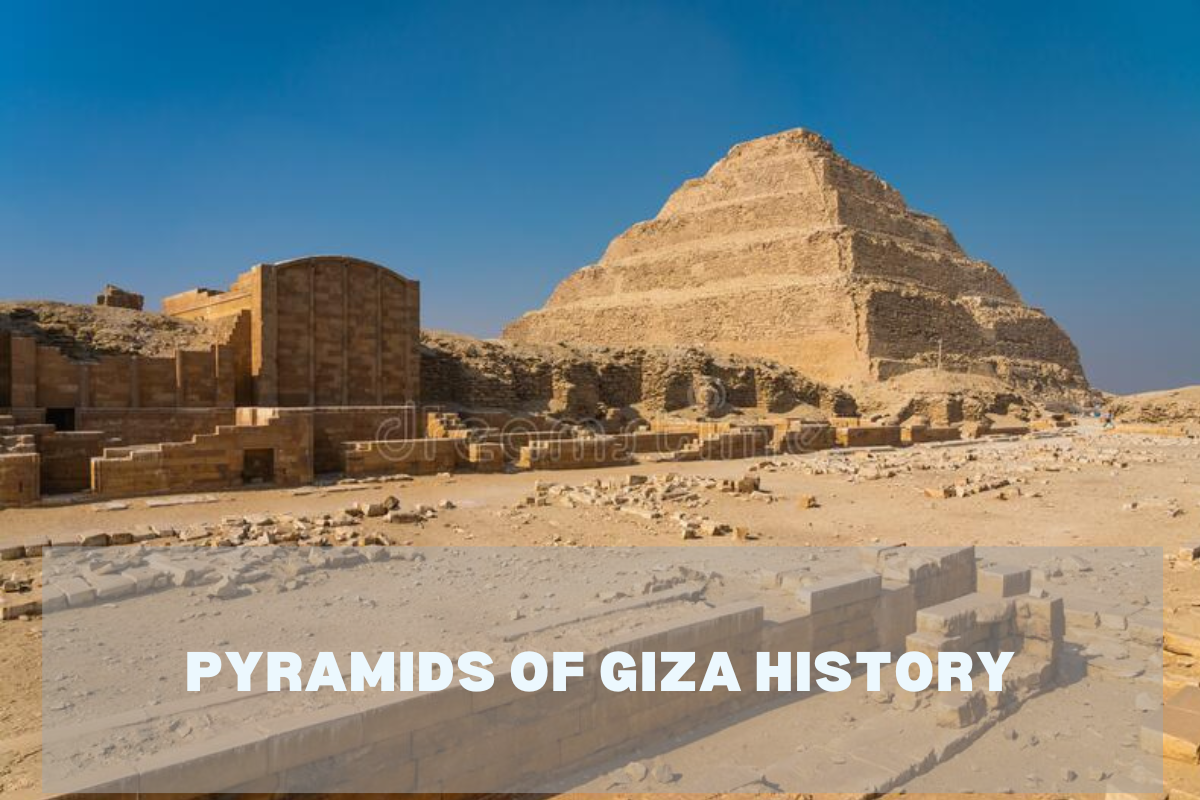The pyramids, especially the Great Pyramids at Giza, were built during an era when Egypt was the richest and most powerful country in the world.
They are some of the most impressive man-made structures ever created.
The pyramids’ immense size reflects the unique role of the pharaoh (or king) in ancient Egyptian society.
Pyramids were constructed from the Old Kingdom’s beginning to the end of the Ptolemaic period, which was in the fourth century A.D. The peak of pyramid building occurred with the third dynasty and continued through the sixth (c. 2325 B.C.).
Pyramids of Giza History
The Egyptian pyramids, which date back more than 4,000 years, still maintain much of their grandeur, giving a glimpse into Egypt’s rich, glorious past.
Egyptian Society: The Pharaoh

Egypt experienced great economic stability and prosperity during the Old Kingdom’s third and fourth Dynasties.
The unique position of kings in Egyptian society was unmatched.
They were thought to be somewhere in the middle of divine and human and to have been chosen by gods to act as their mediators.
It was therefore in everyone’s best interest to preserve the king’s power even after his death.
Osiris, the god of the dead, was then believed to have become Osiris.
In turn, the new pharaoh became Horus, the falcon god who protected the sun god Ra.
Ancient Egyptians believed that a part of the king’s spirit (known as “ka”) would remain with his body after his death.
The corpse was mummified to ensure that his spirit was well cared for.
All the items the king would require in the afterlife, such as gold vessels, food, and furniture, were buried with him.
The pyramids were the focal point of a cult after the death of his king.
They would provide for him and his family, as well as the officials, priests, and relatives who were buried nearby.
The Early Pyramids
The Dynastic Era began in 2950 B.C. Royal tombs were carved in rock and covered with rectangular, flat-roofed structures called “mastabas”, which were precursors of the pyramids.
Around 2630 B.C., Egypt’s oldest pyramid was constructed. Saqqara, home to the third dynasty’s King Djoser.

It is also known as the Step Pyramid. It started as a traditional mastaba, but it grew to be something far more ambitious.
According to legend, Imhotep was the pyramid’s architect.
He was a priest and healer, who would become the patron saint for scribes, and physicians, some 1,400 years later.
Six stepped layers of stone were built by pyramid builders over the 20-year Djoser reign.
It was the tallest building at the time, reaching a height of nearly 204 feet (62 meters).
Djoser could spend his final days in paradise, surrounded by a series of courtyards, temples, and shrines.
However, none of the plans made by his dynastic descendants were ever completed due to their short reigns.
The Red Pyramid at Dahshur was the first tomb to be constructed as a true (smooth-sided and not stepped) pyramid.
It was one of three burial structures that Sneferu, the fourth dynasty’s first king, built-in 2613-2589 B.C.
Named after the color of the limestone blocks that were used to build the core of the pyramid, it was also called the Red Pyramid at Dahshur.
Or you might want to read How To Utilize Crystal Pyramids: The Ultimate Guide To Uses and Healing Benefits
Giza’s Great Pyramids

The Great Pyramids of Giza are the most famous pyramid.
They are located on the west bank of the Nile River on the outskirts of Cairo.
The Great Pyramid is the oldest and largest of the three Giza pyramids.
It is the last remaining structure of the Seven Wonders of the Ancient World.
It was built by Pharaoh Khufu (Cheops in Greek), Sneferu’s successor and second of eight kings from the fourth dynasty.
Khufu ruled for 23 years (2589-2566 B.C. Although Khufu ruled for 23 years (2589-2566 B.C.), little else is known about his reign besides the splendour of his pyramid.
Its original height was 481.4ft (147m), and the sides of the pyramid’s foundation average 755.75 feet (230m).
This makes it the largest pyramid in the entire world.
The Great Pyramid is surrounded by three small pyramids,
one for each of Khufu’s queens, and nearby was a tomb containing the empty sarcophagus of his mother, Queen Hetepheres. Khufu’s pyramid is like other pyramids.
It is surrounded by rows of mastabas where the relatives and officials of the King were buried to support him in his afterlife.
The middle pyramid of Giza was constructed for Pharaoh Khafre’s son Khufu (2558-2532 B.C).
The Pyramid of Khafre, which is second in height at Giza, contains the tomb of Pharaoh Khafre.
The Great Sphinx was a unique feature within Khafre’s pyramid compound.
It is a limestone guardian statue with the head and body of a man and a lion.
It measured 240 feet in length and 66 feet in height.
The 18th Dynasty (c. 1550 B.C. The Great Sphinx would be worshiped as a local version of the god Horus, during the 18th dynasty (c. 1500 B.C.).
Khafre’s son Menkaure built the southernmost pyramid of Giza (2532-2503 B.C.).
It is the shortest pyramid (218 feet) and a precursor to the smaller pyramids which would be built during the fifth and sixth Dynasties.
Or you might want to read: How Old Are The Pyramids
Who built the Pyramids?
Although some historians believe that the pyramids were constructed by foreign workers or slaves, the skeletons found in the area suggest that they were actually built by native Egyptian agricultural laborers.
They worked on the pyramids when the Nile River was flooding much of the surrounding land.
To build Khufu’s Great Pyramid, approximately 2.3 million blocks of limestone (each weighing 2.5 tons) were needed to be cut, transported, and assembled.
It took twenty years to build, according to the Greek historian Herodotus.
However, later archaeological evidence suggests that it might have taken around 20,000 men.
The End of the Pyramid Era

Although pyramids were still being built in the fifth and sixth Dynasties, their quality and scale declined along with the wealth and power of the kings.
The pyramid builders started to write written accounts of events during the reign of King Unas (2375-2235 B.C.) on the walls of his burial chamber and in the interior of the pyramid.
These are known as pyramid texts and they are the earliest religious compositions from ancient Egypt.
Pepy II (2178-2184 B.C.) was the last great pyramid builder. Pepy II (2278-2184 B.C.), was the last of the great pyramid builders.
He was a young boy who ruled for 94years. The Old Kingdom was experiencing a decline in prosperity at the time of his rule.
As the power of non-royal administrative officers grew, the quasi-divine status of the pharaoh began to wane.
Pepy II’s pyramid at Saqqara, which he built around 30 years into his reign was shorter than other pyramids of the Old Kingdom (172 feet).
Pepy’s death caused Egypt to enter a turbulent period known as the First Intermediate Period.
The strong central government and kingdom were virtually destroyed.
The 12th Dynasty’s kings would later return to pyramid building in the Middle Kingdom phase.
However, it was not on the same scale of the Great Pyramids.
The Pyramids Today
In modern and ancient times, tomb robbers and other vandals removed the majority of the bodies and funeral items from Egypt’s pyramids.
They also plundered their exteriors.
The Great Pyramids have lost most of their limestone coverings. Khufu’s is only 451 feet tall.
Millions of people still visit the pyramids every year, attracted by their majestic grandeur and the timeless appeal of Egypt’s rich, glorious past.




